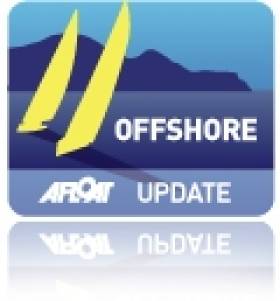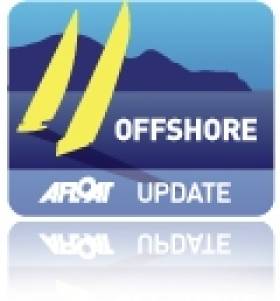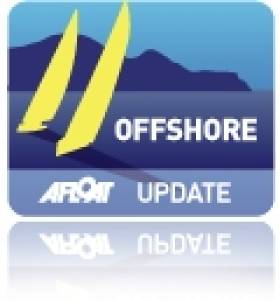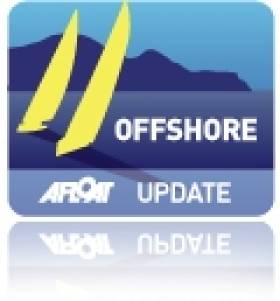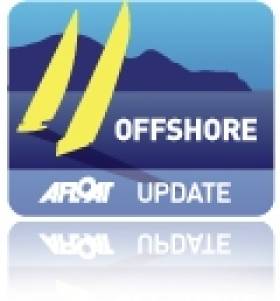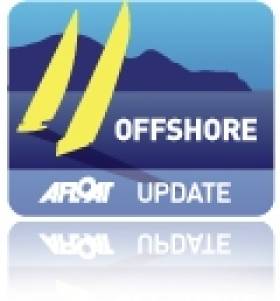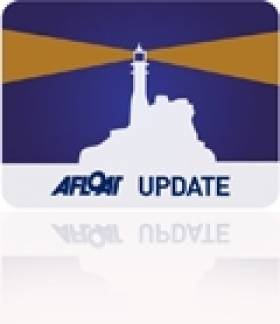Displaying items by tag: Offshore
Five Super Maxis in Fleet of 97 Signed On For 2013 Rolex Sydney Hobart
#sydneyhobart – One year out from the 70th anniversary race, the Cruising Yacht Club of Australia announce that 97 entries have been received for the 2013 Rolex Sydney Hobart Yacht race, including five super maxis, 22 international entries, 15 new boats, 36 first timers, previous overall and line honours winners and the many supportive regulars, the 'meat' of the fleet.
At the pointy end of the fleet, one of the most compelling in years, is defending triple crown holder Wild Oats XI (Bob Oatley) taking on what is allegedly the fastest racing super maxi in the world, Loyal (Anthony Bell). It is purported the former Speedboat/Rambler is capable of making 45 knots downwind.
That knowledge alone will have Wild Oats XI skipper Mark Richards and his crew working even harder than ever, as they did when George David was ready to head this way for the 2011 race when he owned Rambler. Then its keel snapped off in the 2011 Rolex Fastnet Race.
There are 22 international entries, a record of sorts. The 50th anniversary race in 1994 produced 25 internationals from its 371 entries. During the 1970's and '80's, the numbers came close in the odd numbered years when the Southern Cross Cup was in vogue and fleet numbers were well over 100.
This time, boats from New Zealand, United Kingdom, Hong Kong, Singapore, New Caledonia, Germany and Cyprus will take their places on the start line.
With so many unknown quantities in the race this year, because of new boats, those trading up to other yachts and first timers, favourite contenders for the overall win is in the lap of the gods, but there are some regulars whose form is good.
Previous overall winners up for the challenge include Kim Jaggar/Travis Read's Illusion (1988), Roger Hickman's Wild Rose (1993), James Cameron's Luna Sea (as AFR Midnight Rambler in 1998), Philip Child's Knee Deep (as Yendys in 1999) and John Newbold's Primitive Cool (as Secret Mens Business 3.5 in 2010).
The final fleet for this year's Rolex Sydney Hobart will be announced at the CYCA on the morning of Tuesday 26 November, 2013
Dublin Sailor Leads the Fleet From Dubai to Muscat
#offshore – Dublin''s Adrian Lee leads the fleet out of Dubai in a non stop offshore race to Muscat today. The Dun Laoghaire Cookson 50, Lee Overlay Partners from the Royal St. George Yacht Club was given a royal send off when HH Sheikh Khaled Bin Zayed Al Nehayan, President of the UAE Sailing and Rowing Federation, was the guest of honour for the start of the 22nd edition of the Dubai to Muscat Yacht Race.
All the yachts are now sailing 360-miles non-stop to Muscat.
Lee is no stranger to international offshore success taking RORC's Caribbean 600 in 2009.
Scroll down this page to listen to an interview with Adrian from the race course via satellite phone with Louay Habib.
Morning Glory Expected Tonight in Middle Sea Race
#offshore – Kristina Plattner's Z-86, Morning Glory has enjoyed fresh breeze along the west coast of Sicily but not enough to have a chance of breaking the course record writes Louay Habib. Morning Glory needs to finish the race before midday but is likely not to cross the line at around midnight. At 0900 on Day Three, Morning Glory was still leading on the water, just ten miles ahead of Andres Soriano's Mills 72, Alegre. JV72, Robertissima III, skippered by Vasco Vascotto is six miles behind Alegre. Both of the Mini Maxis can still threaten the leader for Line Honours.
Whilst Morning Glory is expected to be the first boat to finish, there is always a huge reception for the first Maltese yacht to return to the Royal Malta Yacht Club. This year, a record number of 13 Maltese yachts are competing. Edward & Aaron Gatt Floridia's Otra Vez is leading the local boats, just 15 minutes ahead of Lee Satariano's Artie-RTFX at Stromboli.
At 0900 this morning, Alex Thompson's IMOCA 60, Hugo Boss has a nine mile lead over Gaes, co-skippered by the Spanish duo of Anna Corbella and Gerard Marin. The two IMOCA 60s have enjoyed a close battle for the last 440 miles of racing and will be enjoying the amazing scenery as they round the beautiful island of Pantelleria.
All of the competing yachts have now passed the impressive active Volcano, Stromboli.
IRC OVERALL at Stromboli
Alegre – Andres Soriano (GBR)
Alegre passed Stromboli nearly 24 hours ago, in the early hours of Day Two. All yachts racing have now passed this way point and the British Mini Maxi was leading the race overall.
Since Stromboli, the larger high performance yachts found enough wind to escape the light winds north of Sicily but the heavy displacement and smaller yachts have not. The conditions for the first two days suited the heavy displacement yachts but the high performance light weight yachts are reaping rich rewards for making the fresh breeze west of Sicily.
A windless zone developed near Stromboli and over night, the bulk of the fleet were becalmed. Effectively there had been a re-start for these yachts at Stromboli. However spirits are high, even though progress literally ground to a halt overnight.
IRC Double Handed at Stromboli
TWT UComm - Marco Rodolfi (ITA)
The double handed class is being dominated by the powerful Class 40, TWT UComm. The Italian yacht skippered by Marco Rodolfi, who also owns the highly successful Swan 80 Berenice, has Matteo Auguadro on board, one of Italy's finest sailors. Matteo has competed in the America's Cup, World Match Racing Tour and is a winner of the Rolex Mini Maxi World Championship.
Racing in IRC Double Handed, Georges Bonello Dupuis reported from on board Escape with Tommy Hilfiger. The former Royal Malta Yacht Club Commodore is sailing with Shaun Murphy.
"We came out of Messina like we had been shot out of a cannon!" exclaimed George. "30 knots of wind from behind and we were sitting at 12 knots of boats speed for a long time. I have never experienced that in my life. Excitement turned to near disaster though as, the halyard let go and the spinnaker fell into the water. It took the two of us a lot of back-breaking work to recover it, repack it and re-hoist, but that is what double handed sailing is all about; it is a challenge that we love to take on. Right now we have come to a virtual stop in no wind, I can count 64 yachts around us and we are enjoying a simple dinner, watching the sunset set to the west with Stromboli to the east and the Aeolian Islands to the south. We have the best table in the house!"
IRC ONE at Favignana
Alegre - Andres Soriano (GBR)
Leader on corrected time at Favignana was British Mills 72, Alegre. Marton Jozsa's Hungarian RP60, Wild Joe had a great leg to the north west corner of Sicily deposing the Italian JV72,Robertissima down to third in class. With over half the race completed, the chance of one of these three yachts winning the race overall after time correction is constantly improving.
IRC TWO at Favignana
B2 - Michele Galli (ITA)
At 0900 on Day Three, Michele Galli's B2 was approaching Pantelleria, 215 miles from the finish. On corrected time the Italian team was an hour ahead of their Italian rivals at Favignana. However, Roberto Lacorte's Baltic 65, Nikka 65 is very close behind. Both yachts have an identical rating. The first to cross the line is likely to win the class and have a very good chance of an overall win. Germana Tognella's Italian Cookson 50, Cantankerous was in third place at Favignana, threatening the leaders.
IRC THREE at Stromboli
Lilla - Simon De Pietro (IRL)
Simon De Pietro's scarlet 76 foot sloop, Lilla was leading the class at Stromboli. The multinational crew have tasted offshore honours before, winning class at this year's RORC Caribbean 600. The much travelled yacht has a highly experienced crew and the slow down after Stromboli has given the beautiful classic yacht some advantage, due to its lower rating. Amanda Hartley's Spanish Swan 56, Clem dropped to second place but is only 5 minutes off the lead and James Blackmore's South African Swan 53, Music is in third.
IRC FOUR at Stromboli
Infanta-Freddie Hall (GBR)
Infanta may have lost the overall lead but the classic British yawl is still winning her class at Stromboli. Gherardo Maviglia's Roman Oceanis 430, Amapola has shot up the leader board into second in class whilst Genovese Sun Fast 3200, Hakuna Matata is third in class at Stromboli.
New Transatlantic Race for 2014 Announced by RORC
#offshore –A brand new offshore race taking yachts from Europe to the Caribbean has been annuonced by leading offshore body, the Royal Ocean Racing Club in London. The RORC Transatlantic Race will set off from Lanzarote, Canary Islands and finish in the Caribbean, at a destination to be confirmed. The 2,800 nm east to west race will act as a feeder for yachts participating in the 2015 RORC Caribbean 600, held annually in February from Antigua.
The RORC racing calendar attracts sailors from all over the world to compete during the season in over 20 races and comprises a series of highly competitive inshore and offshore IRC Rated events throughout the year. The new RORC Transatlantic Race will be the longest and final race in 2014, making it another busy year for the London-based Club. It follows a season of regular RORC races as well as the international Sevenstar Round Britain and Ireland Race and Brewin Dolphin Commodores' Cup.
"In the past the club has been involved with the Atlantic Rally for Cruisers (ARC) who have a racing division, but with increasing interest in the RORC Caribbean 600 every February, the number and quality of serious race boats making the crossing has required a specialist RORC event all of its own," explains RORC Commodore, Mike Greville. "We're delighted to be working with such keen racers as the Calero family and using the fabulous marina facility they have in Lanzarote and we look forward to a long and happy relationship."
Puerto Calero - Host Port
The host port for the start of the race will be the 450-berth Puerto Calero Marina situated on the south side of Lanzarote, only 15 minutes from the island's international airport. The Calero family are no strangers to hosting big events.
"We are delighted the RORC has chosen our marina to host the start of the RORC Transatlantic Race in November next year," said José Juan Calero. "We have all the facilities required by a yacht making an Atlantic crossing: a fully equipped boat yard and repair service, food and supply shops and we are very proud of all the restaurants and hotels we have around the marina. These all make for a pleasant and relaxing time for competitors in advance of the start."
In November, Puerto Calero will once again play host port to the RC44 Championship Tour. Returning to Lanzarote for the sixth consecutive year since 2008, this will be the third time the Island has hosted the Championships. It is one of three classes - TP52 and GP42 - to have held their world championships at Puerto Calero.
The marina is also home to Team SCA, the all female crew training for the 2014-15 Volvo Ocean Race and Ericsson, Groupama and Puma have held training camps here in recent years.
Canarian Meander
Lanzarote is the most eastern island of the Canarian archipelago and it is the RORC's intention that the race course will meander through the islands before venturing out into the Atlantic.
The race, commencing over the weekend of the 28th and 29th November 2014, will be run under OSR Category 1 and the start date will allow time for competitors in the Rolex Middle Sea Race to get to the start of the RORC Transatlantic Race in good time and for the yachts to finish in the Caribbean before Christmas.
To register interest and for more information, contact the RORC Race Office: T: +44 (0) 207 518 3131 and email: [email protected]
Record Entry for Malta's Offshore Middle Sea Race
#middlesearace – The Royal Ocean Racing Club has been a supporter of the offshore Rolex Middle Sea Race for over 50 years and the 35th edition of the race has a record entry of over 111 yachts writes Louay Habib. For the first time the 606-mile race, starting and finishing in Malta, is included in the RORC Season's Points Championship and a number of boats are attending the event with the aim that their results could affect the final standings. Two Irish yachts are entered in the race.
"The Royal Ocean Racing Club were co-founders of the race with the Royal Malta Yacht Club in 1968 and the Rolex Middle Sea Race is an important event in our calendar. Therefore the RORC Committee concluded that it should be included in the Season's Points Championship," commented RORC CEO, Eddie Warden Owen.
This, the last race of the RORC Season's Points Championship, could affect the results in two IRC classes. Derek Saunders' CM60, Venomous, is currently lying second in IRC Zero for the season but a good result in the Rolex Middle Sea Race could see the British boat secure the class ahead of the current leader, Harm Prins' Dutch Volvo 60, Pleomax. Two production yachts have made the long journey to Malta from the Solent to take part in the race. RORC Admiral, Andrew McIrvine's First 40, La Réponse, and past RORC Commodore, Peter Rutter racing Grand Soleil 43, Trustmarque Quokka. Whilst neither yacht will be able to overtake Géry Trentesaux's Courrier Vintage to win IRC Two they have a chance of taking second place overall. The two boats have enjoyed a close rivalry over many months and the final score will be settled in Malta.
The overall winner of the Rolex Middle Sea Race is decided by the best corrected time under IRC and currently 96 yachts will be racing in four classes using the Spinlock IRC rating system.
One of the favourites to win the Rolex Middle Sea Race overall under IRC could be Andres Soriano's Mills 72, Alegre. This innovative and latest Mini Maxi to be launched will be taking part in its first long distance offshore race. Alegre's navigator Will Best explained why an overall win is so difficult to achieve.
"We will have a hard enough time just winning our class," commented Will. "Hugo Boss will be difficult to match off the breeze in more than 15 knots and Esimit Europa 2 could get away in the light and possibly into another weather pattern. Nobody can predict the overall winner, there are many well sailed boats in other classes and they can have a totally different weather scenario. The ideal conditions for Alegre would be a stable weather pattern, where we all get the same conditions on the course. We just hope we get the right conditions for Alegre and we sail the boat as well as we can but racing under IRC on this course makes it wide open. Any boat that sails well and gets the right conditions is in with a chance."
Although the Rolex Middle Sea Race attracts some of the world's top professional teams, the last two editions have been won by Corinthian entries. In 2012 Eddie De Villiers' Royal Cape Yacht Club team, racing Hi Fidelity, was victorious. In 2011 the whole island was celebrating as Lee Satariano and Christian Ripard's Artie-RTFX, with an all-Malta team, were the overall winners. Neither yacht had a big budget campaign and
Irish Youth Sailors Share in Nord Stream Race Success
#nsr – Celebrations are in progress in Saint-Petersburg, Russia today as Team Great Britain onboard Swan 60 Tsaar Peter has just won the Nord Stream Race 2013 in the Gazprom Swan 60 Class! The British entry has two Irish youth sailors James O'Mahony and Simon Johnson onboard under skipper Adrian Stead.
After an exciting and nail biting race, which saw the Swan 60 fleet change race positions a number of times throughout the 800 nautical mile course, Team Great Britain were finally victorious and crossed the finish line in Saint-Petersburg at 03:33am local time. The team had managed to hold onto their first place position for the final 100nm of the race and beat previous race winners, Team Russia by just 26 seconds.
A fantastic finish to the Nord Stream Race saw Team GBR and Team Russia battle it out right to the end, crossing the finish line with less than a boats length between them. Over an 800nm race this is exceptional and the final few miles were dramatic to watch, with the 60ft yachts tacking and fighting hard for the first place position.
Speaking dockside as the winning crew celebrated, Skipper Adrian Stead commented; "The whole race was very close, the fleet stuck together the whole way. Earlier on we managed to get quite a good lead but then Team Russia and Team Germany sailed up to us again, then we got away again and in the last 100 miles we were trying so hard to keep Team Russia behind us, for most of that time there was only a 2-3 mile gap between us.
The last 10 miles to the finish became very light and Team Russia came up with a bit more wind from behind, we did quite a few tacks in the final few miles and we managed to hang onto our position and win. It has been absolutely mad! I give full credit to Team Russia and the other boats as they pushed us really hard.
It has been really great though, not a bad result for our first go at the Nord Stream Race! We had a fantastic team who have all been brilliant, all of them put in 110%. We have all been up on deck for the last 16 hours of the race, hiking it out and making sure every boat length worked. We pushed the boat incredibly hard and it all paid off for us, what brilliant results."
Jules Salter, Navigator onboard Team GBR spoke of the challenges throughout the race; "The race became a bit tricky at the end with all of the restrictions, there was a military zone and a test firing zone plus the commercial ships passing by; there was definitely plenty going on as we approached Saint-Petersburg. Overall it was a really interesting race, there were lots of weather situations going on and we were always close to land which had an effect on the weather, but it was really good.
I haven't sailed on a Swan 60 before and I would say it was quite nice; it was very quiet down below. On the race boats I usually sail on, you go down below and it sounds like all hell is breaking loose but on here it was quite relaxing and quiet down there which makes a great change. The Swan 60s are nice easy boats to sail and all even in speed, it was a great race with the other four boats."
Team Russia finished just 26 seconds behind Team Great Britain, an unheard of result in such an offshore race. Whilst dockside congratulating Team Great Britain, Tommaso Chieffi of Team Russia commented; "As we came towards the finish, I said to my boys that we should stop the roster as the best thing for the race would be to have a close finish! The crew which I really thank for the results, really pushed for the last 12 hours, without sleeping, without resting, everybody on the rail, it was not easy.
But we had what we hoped for with a close finish, it was a very competitive race and I think a different winner in year two makes the race more exciting. After 800 miles it is fairly unbelievable to think that you could finish with two boats so close together, with only one boat length separating us. Adrian Stead and his boys deserved the win, we are very pleased for them, they have been leading from day one and they had a great race, so congratulations to them."
In third place came Team Germany, followed by Team Turkey in fourth and Team Europe in fifth place. With only 5 hours between the 1st and 5th boat finishing, this has highlighted just how competitive the one-design Swan 60 Class has become, a Class which challenges sailors on their sailing ability, experience and knowledge. Over the 800 nautical miles each Swan 60 had taken the lead position at some point along the course, a fact which kept race followers guessing until the final moments and boats fighting it out the whole way.
Now docked along the English Embankment in Saint-Petersburg, the five Swan 60 yachts are an eye catching edition to the River Neva. Race crews will now have a well-earned rest before discovering the sights of Saint-Petersburg over the weekend; they will also enjoy a gala dinner at a prestigious venue in the city before a final prize giving takes place on Sunday at the Maritime Museum, Saint-Petersburg.
The Nord Stream Race has also concluded the Gazprom Swan 60 Class Circuit 2013.
Irish Youths on Great Britain Out in Front in NSR as Saint-Petersburg Finish Looms
#nsr – Team Great Britain with Irish youth sailors James O'Mahony and Simon Johnson on board may have been new to the Nord Stream Race this year, but they are certainly not letting that hinder their performance, as they have now taken the Nord Stream Race lead on the approach towards the finish in Saint-Petersburg, Russia. At 1100 CET the teams have around 100 nautical miles to go and we will all be watching intently to see if Team Great Britain can hold onto their first place position.
The latest onboard news from Skipper Adrian Stead, Team GBR indicated that "everyone is doing fine onboard and we are reaching under spinnaker to the North in about 22 knots of wind." They could also see some of the other Swan 60 boats with their spinnakers up. A slow night on Tuesday meant that the teams all tried to move away from one another, leading to a slight splitting of the fleet and a change in race positions.
Second place is currently held by last year's Nord Stream Race winners Team Russia, and they will no doubt have more local knowledge of the waters here in the approach to Saint-Petersburg. Team Germany, Team Europe and Team Turkey are also not far behind the two leaders, with only 30 nautical miles separating the 1st and 5th boats at this point in the race. Over 800 nautical miles this has been, and continues to be an extremely close race, highlighting the sheer competitiveness of the one-design Gazprom Swan 60 Class and the skill of the sailors onboard. The boats will be fighting it out all the way to the finish line.
News from Robert Klein onboard Team Turkey this morning reveals their current situation; "we are trying to hold on to the position which we have fought very hard for over the past day and night, this is a very tough job. The weather has fundamentally changed over-night with winds of up to 29 knots, high waves and rain pouring down, the work we put in over-night was exhausting but we want to maintain our position. The situations continue to be tough and we are all very busy this morning, we need to seek the right windy patches. Despite the weather conditions everyone onboard is well and in a good mood."
The Swan 60s are currently sailing into the Gulf of Finland and sailing at around 8 knots; if they maintain this speed they should cross the finish line either late this evening or into the early hours of Saturday morning. As all teams approach Saint-Petersburg they will need to be highly alert as they are entering a very busy commercial shipping lane, there are unknown elements to the race in this final stretch and teams will have to use all of their skills to navigate to the finish line whilst holding their race positions.
Once in Saint-Petersburg, the city of palaces, the five crews will be greeted by the race organisers and some well needed refreshments! They will also have chance to enjoy a tour of the city over the weekend, whilst also celebrating their accomplishment with a gala dinner and a prize giving in the Saint-Petersburg maritime museum.
Weather Troubled Irish Catamaran Arrives Safely In Cornwall
#Offshore - A catamaran sailing from Ireland to Cornwall has arrived safely at Newlyn harbour after a 22-hour journey troubled by poor weather.
As This Is Cornwall reports, the vessel was being monitored by Falmouth Coastguard after its original plans to dock at Falmouth were scuppered by inclement conditions at sea and a lack of fuel.
Ireland-Bound Couple In Stormy Waters With US Harbour
#Offshore - A retired US couple bound for Ireland on their sailing yacht encountered a storm of a different kind when they sought safety from hurricane-force winds in the Port of New Bedford.
According to Massachusetts news site South Coast Today, Gary and Jodi Bratton last month attempted to drop anchor in the harbour, a federally designated anchoring area - but were blocked by New Bedford's Harbour Development Commission, who demanded they either anchor beyond the hurricane barrier or take a city mooring charged at $45 per night.
"The right of navigation comes with it the right to anchorage," said Gary Bratton, who was headed to Galway Bay with his wife. "We didn't feel like we were in a position to negotiate. We're in trouble. We're hurt."
But morning manager Bob Bouley defended the harbour's actions, noting that visiting boaters are being discouraged from anchoring in the area for safety reasons due to construction work around the port's south terminal.
New Bedford shows as a harbour of refuge on US federal charts, says local yachtsman Jeff Pontiff, who adds that the harbour company has had some difficulties reconciling this with the operation of its busy shipping port.
South Coast Today has more on the story HERE.
Plymouth Gets Set to Welcome Fastnet Race Competitors
#fastnet – Plymouth is gearing up to welcome thousands of sailors from all corners of the globe in the Royal Ocean Racing Club's celebrated Rolex Fastnet Race. Now in its 45th edition the biennial race, which started in 1925, features on every seasoned sailor's 'must do' list as well as newcomers seeking a tough personal challenge. Drawn by the history and sporting lure of Europe's oldest and greatest offshore contest, it is legendary within the world of ocean racing.
The 2013 race has already set new records before it's even started: up to 380 boats from over 20 countries, from as far afield as Australia, Russia, America and Lithuania, will converge on the historic maritime City of Plymouth for the finish of the 608 nautical mile race which sets off from Cowes, Isle of Wight on Sunday 11th August.
The race which sees the mammoth fleet round the iconic Fastnet Rock before heading to the finish, showcases the most diverse range of yachts imaginable; from 30ft to 130ft and attracts aspiring sailors to professional crews who race all over the world. Accommodating the largest ever Fastnet fleet and around 3,500 competitors has been made possible by the move to Mount Batten's Plymouth Yacht Haven.
"Plymouth Yacht Haven, Mount Batten has the capacity to supply the extra berthing that is needed in this record breaking year. With so much demand, we had to find a solution and moving the event to Plymouth Yacht Haven and working with Queen Anne's Battery, Sutton Harbour and Mayflower marinas will give us the capacity we need to berth a fleet of this size and provide the facilities expected by the sailors," says Royal Ocean Racing Club's CEO, Eddie Warden Owen.
Also new for 2013 will be the Acoustic Circus in the Race Village, providing top entertainment each afternoon from Tuesday 13th through to Friday 16th August and luckily for those competing, the finish of the race coincides with the British Fireworks Championships, so it is set to be a spectacular week for both visitors, locals and the yachtsmen alike.



























